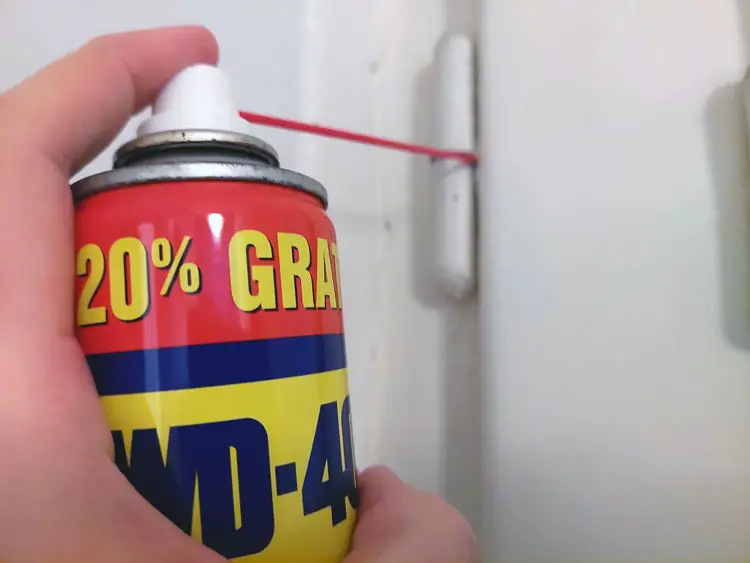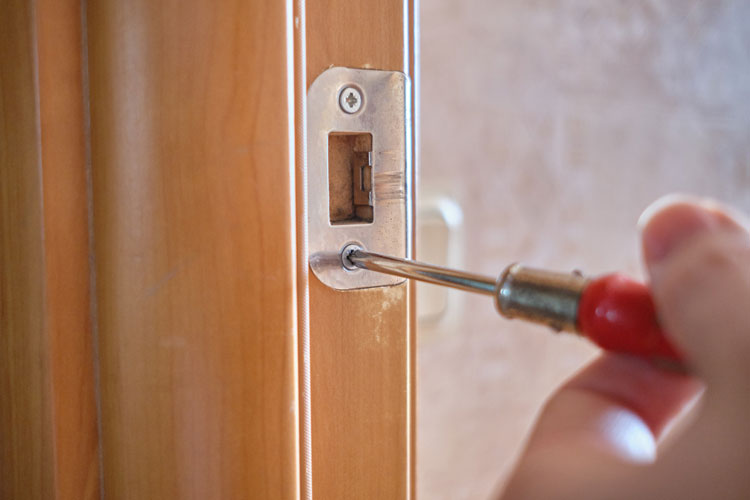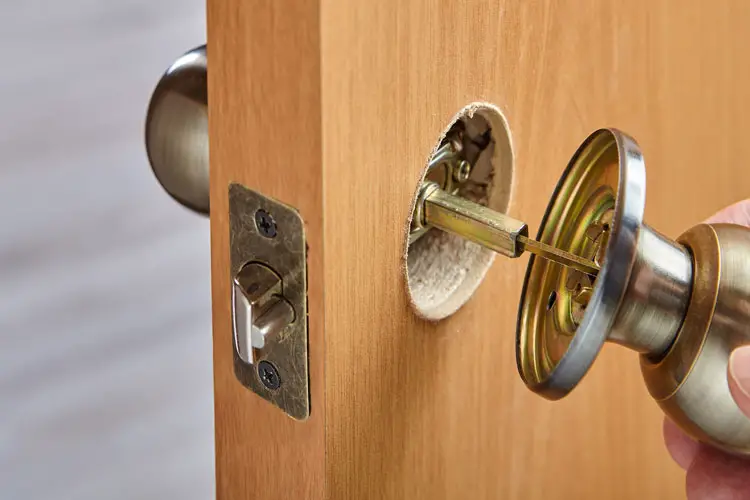Few things can be as frustrating as a stubborn, jammed door that refuses to open no matter how hard you pull or push.
Whether it’s due to humidity, warping, a faulty lock, or a broken hinge, a jammed door is a really annoying problem that you need to solve quickly.
If you can’t get your door open, do not panic! In this article, I’ll show you some simple and effective ways and techniques to quickly fix a stuck door.
Let’s start with the possible causes:
- Jammed deadbolt, broken doorknob, or other hardware issues (such as sticking out strike plate)
- Warped door
- Misaligned door frame
- Rusty or loose hinges
- Swollen door due to humidity
- Obstruction in the door frame (objects or debris lodged in the door frame)
- Damaged or broken door latch
- Structural issues within the building such as foundation issues or settling
Here’s How You Can Quickly Find the Cause of a Jammed Door
- Inspect the door frame: Examine the door frame for any visible signs of misalignment, such as gaps or unevenness.
- Check the latch and strike plate: A jammed lock is not unusual. Try turning the doorknob or lever. If there is resistance or the latch doesn’t retract fully, the latch mechanism may be misaligned, damaged, or in need of lubrication. If you have access, examine the strike plate on the door frame for any misalignment or damage.
- Examine the door material: Look for signs of warping, such as visible curves or gaps along the edges. Run your hand along the door’s surface to feel for any irregularities or swelling caused by moisture.
- Observe the hinges: Check if the hinges are misaligned, bent, or deformed. If you can, gently lift the door to check for any loose or squeaky hinges.
- Test the deadbolt or locks: Check the functionality of any locks or deadbolts. Insert the key or engage the door lock mechanism and attempt to lock and unlock the door. If there is resistance or difficulty in operating the lock, it may be damaged or misaligned.
- Remove obstructions: Inspect the door frame and surrounding area for any objects or debris that could obstruct the door’s movement. Remove any obstructions that you find.
- Examine the door edges: Carefully inspect the edges of the door for excessive paint buildup. If there are thick layers of paint, especially near the door frame, it could be contributing to the jamming.
- Consider external factors: If none of the above steps reveal the cause, consider external factors such as settling or foundation issues within the building. Look for any signs of structural problems that may affect the door’s alignment.
How to Open a Jammed Door
1. Use Gentle Force and Leverage
Firmly but gently push or pull the door while simultaneously trying to turn the handle or key.
Sometimes, a combination of slight force and leverage can dislodge the door from its stuck position. Avoid excessive force, as it can potentially damage the door lock, hinges, or door frame.
2. Apply Some Lubricant to the Moving Parts
Apply a small amount of graphite lubricant or silicone spray (such as WD-40) to the lock mechanism, hinges, and any other moving parts of the door.

This can help reduce friction and make it easier to turn the key and operate the lock and will allow the door to move freely. Avoid using oil-based lubricants as they can attract dust and dirt, potentially worsening the situation.
3. Tap the Door and Frame
Use a rubber mallet or the heel of your hand to tap the door near the latch area or along the edge. This can help jostle the components and release any minor obstructions.
Check if the strike plate is sticking out or is misaligned. If so, try tightening the screws. Sometimes you need to completely remove the strike plate and reposition it or use a hammer to remove any misalignment or offset.

4. Use a Credit Card or a Paperclip to Retract the Latch
Credit card or plastic shim
- Insert a sturdy, flexible object like a credit card (that you don’t need anymore), plastic shim, or butter knife between the door and the door frame, near the latch.
- Gently wiggle and push the object while attempting to turn the key or press the door handle, mimicking the action of the latch retracting.

Paperclip or wire
- Straighten a sturdy wire or paperclip and insert it into the small hole on the doorknob or handle (if available).
- Apply gentle pressure and attempt to retract the latch mechanism.
5. Remove the Doorknob
A common problem that causes a sticking door is a broken spring. Taking the doorknob off will allow you to take a closer look at the locking mechanism and open the door if the latch bolt does not recede.
Tools you’ll need:
- Phillips screwdriver
- bobby pin or paperclip (depending on the type of doorknob you have)
Steps to remove the doorknob:
- Depending on what kind of doorknob you have, you will find either a small hole or a slot that you need to push using a bobby pin (or paperclip) or flathead screwdriver to release the knob.
- Remove the decorative plate (rose).
- Loosen and remove the screws that run through the borehole.
- Remove the doorknob.

Here’s how you can also use a simple screwdriver to fix a stuck door:
Keep in mind that this method won’t work with a deadbolt lock. If you’re dealing with a privacy lock, check out this guide.
6. Open the Door by Removing the Hinges
One of the quickest ways to open a jammed door when you’re stuck on the inside (or you’re dealing with an outward opening door) is to remove the hinges.
Here’s how to do that:
Tools you’ll need:
- a hammer
- a nail (or sometimes a screwdriver)
- a book or a piece of cardboard for support
Steps:
- First, locate the hinge pins. The hinge pins are the small metal pins that hold the hinges in place. They are usually located in the center of the hinge.
- To stabilize the door while unpinning it, place a book under it for support. If available, have someone hold the door steady while you proceed to the next step.
- Use the hammer and the nail to tap the bottom of the hinge pins until they are loose.
- Use your hand or the screwdriver to remove the hinge pins completely.
- Once you get rid of the hinge pins, you can remove the jammed door (1).
FYI – If the hinge pins are rusty or corroded, you may need to use a lubricant to help loosen them. Be careful not to damage the door or the hinges when removing them.
7. Adjust the Door Frame
If the jammed door is a result of misaligned hinges or an improper door frame installation, adjustments might be necessary.
Inspect the hinges and screws, ensuring they are securely fastened. Tighten any loose screws and test the door’s movement.
In some cases, you may need to shim or reposition the door frame to alleviate the jamming issue but that requires a certain level of experience so I don’t recommend it if you’re a newbie DIYer.
8. Apply Heat or Cold to Fix Issues Caused by Humidity and Temperature
If the door is made of materials that can expand or contract with temperature or humidity changes, such as wood, you can try using a hairdryer to apply warm air to the door or an ice pack to cool it down (2).
Also, you can try adjusting the temperature or humidity in the room (keep in mind, however, that it won’t have an immediate effect). The slight change in size might free up the door if the cause is excess humidity or warm temperature.
How to Prevent Future Jams
A door that keeps getting stuck is especially frustrating. Here are some practical tips to help you avoid future door-jamming issues:
- Keep the door hinges well-lubricated and free from debris.
- Regularly inspect the door frame, hinges, and locks for signs of wear or damage.
- Replace worn-out or damaged components promptly to maintain smooth operation.
- Excessive humidity or temperature changes can cause doors to swell or warp. Ensure proper ventilation in the area, use a dehumidifier if needed, and consider weatherstripping to minimize the impact of environmental factors.
- Sometimes you may need to sand the bottom or top of the door to prevent it from being stuck.
- Avoid forcefully slamming doors, as this can misalign the components and lead to jams.
- Consider installing doorstops or door holders to prevent doors from swinging shut forcefully.
Additionally, performing routine checks of your doors can help you identify and address potential issues before they escalate into full-blown jams. Take a few minutes every month to examine the condition of your doors and perform any necessary maintenance or adjustments.
When to Seek Professional Help
Resolving a jammed door sometimes may require professional assistance. If you have tried the above-mentioned methods and the door remains stuck, it’s time to call a local locksmith or handyman. These experts have the knowledge, experience, and specialized tools to address complex door-jamming issues efficiently.
When seeking professional help, ensure you choose a reliable service provider. Look for reputable locksmiths or handymen with positive customer reviews and reasonable pricing.
Obtain multiple quotes if necessary and inquire about their expertise in dealing with jammed doors specifically.
Conclusion
Dealing with a jammed door can be frustrating, but with the right approach, it can be resolved effectively. By assessing the situation, utilizing lubrication and maintenance techniques, adjusting the door frame if necessary, and seeking professional help when needed, you can overcome door jamming issues and restore the functionality of your doors.
Remember to prioritize prevention by implementing good maintenance practices and regularly checking your doors for any signs of wear or damage. By doing so, you can minimize the chances of encountering future problems.
FAQs
Can I use any type of lubricant to fix a jammed door?
While there are various lubricants available, it’s best to use silicone spray or graphite powder for door-related issues. These lubricants are specifically designed for smooth operation and won’t leave a sticky residue.
How often should I perform maintenance on my doors?
Performing maintenance on your doors every six months is generally recommended. However, if you notice any signs of wear, stiffness, or unusual sounds, it’s best to address the issue promptly.
Are there any temporary solutions to open a jammed door?
Yes, you can try using a rubber mallet or a hammer with a soft cloth to gently tap the door while attempting to open it. This can help dislodge any stuck parts and provide temporary access.
Is it possible to fix a jammed door without removing the door panel?
In some cases, you may be able to resolve the issue without removing the door panel. Start by using lubricants and gently manipulating the door’s movement to see if it improves. If not, you may need to proceed with removing the panel.












